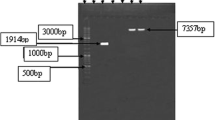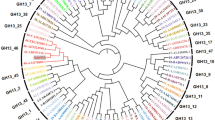Abstract
A gene encoding mesophilic α-amylase from Bacillus subtilis JN16 was identified and designated as AmyQ. The AmyQ gene was cloned, sequenced, and expressed in Escherichia coli. AmyQ is 1,980 bp in length and encodes a protein of 660 amino acids. AmyQ was cloned in plasmid pET20b (+) on an NcoI–BamHI fragment, and used to transform competent E. coli amylase-negative cells (BL21); ampicillin-resistant transformants were screened for the production of α-amylase. The recombinant α-amylase encoded in E. coli was designated AmyQ A, and α-amylase from wild-type B. subtilis strain JN16 was designated AmyQ B. AmyQ A was characterized biochemically and showed maximal activity at pH 7.0 and maximal stability at pH 5.5; the optimum temperature for enzymatic activity was close to 70°C. The optimal pH for purified AmyQ B was 7.5. With soluble starch as substrate, the K m and V max of AmyQ A were 3.40 g/L and 15.70 g/(L min−1), respectively, and the K m and V max of AmyQ B were 2.01 g/L and 6.95 g/(L min−1), respectively. The activity of AmyQ A was enhanced by K+, Mn2+, Co2+ and Ca2+, and the activity of AmyQ B was enhanced in the presence of K+, Co2+ and Ca2+.







Similar content being viewed by others
References
Abe A, Yoshida H, Tonozuka T, Sakano Y, Kamitori S (2005) Complexes of Thermoactinomyces vulgaris R-47 α-amylase 1 and pullulan model oligossacharides provide new insight into the mechanism for recognizing substrates with α-(1, 6) glycosidic linkages. FEBS J 272:6145–6153
Ahmadia A, Ghobadia S, Khajehb K, Nomanpourc B, Dalfardb AB (2010) Purification of α-amylase from Bacillus sp. GHA1 and its partial characterization. J Iran Chem Soc 7:432–440
Asther M, Meunier JC (1990) Increased thermal stability of Bacillus licheniformis [alpha]-amylase in the presence of various additives. Enzyme Microb Technol 12:902–905
Besemer J, Borodovsky M (1999) Heuristic approach to deriving models for gene finding. Nucleic Acids Res 27:3911–3920
Bradford MM (1976) A rapid and sensitive method for the quantitation of microgram quantities of protein utilizing the principle of protein-dye binding. Anal Biochem 72:248–254
Buisson G, Duee E, Haser R, Payan F (1987) Three dimensional structure of porcine pancreatic alpha-amylase at 2.9 Å resolution. Role of calcium in structure and activity. EMBO J 6:3909
Clark D, Kelly R (1990) Hot bacteria. Chemtech 20:554–562
Dong G, Vieille C, Savchenko A, Zeikus JG (1997) Cloning, sequencing, and expression of the gene encoding extracellular alpha-amylase from Pyrococcus furiosus and biochemical characterization of the recombinant enzyme. Appl Environ Microbiol 63:3569–3576
Fukusumi S, Kamizono A, Horinouchi S, Beppu T (1988) Cloning and nucleotide sequence of a heat stable amylase gene from an anaerobic thermophile, Dictyoglomus thermophilum. Eur J Biochem 174:15–21
Fuwa H (1954) A new method for microdetermination of amylase activity by the use of amylose as the substrate. J Biochem 41:583–603
Gupta R, Gigras P, Mohapatra H, Goswami VK, Chauhan B (2003) Microbial [alpha]-amylases: a biotechnological perspective. Process Biochem 38:1599–1616
Igarashi K, Hatada Y, Ikawa K, Araki H, Ozawa T, Kobayashi T, Ozaki K, Ito S (1998) Improved thermostability of a Bacillus alpha-amylase by deletion of an arginine-glycine residue is caused by enhanced calcium binding. Biochem Biophys Res Commun 248:372–377
Igarashi K, Ozawa T, Ikawa-Kitayama K, Hayashi Y, Araki H, Endo K, Hagihara H, Ozaki K (1999) Thermostabilization by proline substitution in an alkaline, liquefying α-amylase from Bacillus sp. strain KSM-1378. Biosci Biotechnol Biochem 63:1535–1540
Jespersen HM, Ann MacGregor E, Henrissat B, Sierks MR, Svensson B (1993) Starch-and glycogen-debranching and branching enzymes: prediction of structural features of the catalytic (β/α) 8-barrel domain and evolutionary relationship to other amylolytic enzymes. J Protein Chem 12:791–805
Khajeh K, Nemat-Gorgani M (2001) Comparative studies on a mesophilic and a thermophilic α-amylase. Appl Biochem Biotechnol 90:47–55
Kumar S, Tamura K, Nei M (1994) MEGA: molecular evolutionary genetics analysis software for microcomputers. Comput Appl Biosci: CABIOS 10:189–191
Lin LL, Huang CC, Lo HF (2008) Impact of Arg210-Ser211 deletion on thermostability of a truncated Bacillus sp. strain TS-23 α-amylase. Process Biochem 43:559–565
Lineweaver H, Burk D (1934) The determination of enzyme dissociation constants. J Am Chem Soc 56:658–666
Ludlow JM, Clark DS (1991) Engineering considerations for the application of extremophiles in biotechnology. Rev Biotechnol 10:321–345
Nielsen JE, Borchert TV (2000) Protein engineering of bacterial [alpha]-amylases. Struct Mol Enzymol 1543:253–274
Richèle DW, Joost CMU, Reinetta MB, Bauke WD, Lubbert D (1998) Engineering of cyclodextrin product specificity and pH optima of the thermostable cyclodextrin glycosyltransferase from thermoanaerobacterium thermosulfurigenes EM1. J Biol Chem 273:5771–5779
Sajedi RH, Taghdir M, Naderi-Manesh H, Khajeh K, Ranjbar B (2007) Nucleotide sequence, structural investigation and homology modeling studies of a Ca2+-independent α-amylase with zcidic pH-profile. J Biochem Mol Biol 40:315–324
Thompson J, Higgins DG (1994) Clustal W: improving the sensitivity of the progressive multiple sequence alignment through sequence weighting, positions-specific gap penalties and weight matrix choice. Nucleic Acids Res 22:4673–4680
Tomizawa H, Yamada H, Wada K, Imoto T (1995a) Stabilization of lysozyme against irreversible inactivation by suppression of chemical reactions. J Biochem 117:635–640
Tomizawa H, Yamada H, Hashimoto Y, Imoto T (1995b) Stabilization of lysozyme against irreversible inactivation by alterations of the Asp-Gly sequences. Protein Eng 8:1023–1028
Vieille C, Burdette DS, Zeikus JG (1996) Thermozymes. Biotechnol Annu Rev 2:1–83
Violet M, Meunier JC (1989) Kinetic study of the irreversible thermal denaturation of Bacillus licheniformis alpha-amylase. Biochem J 263:665–670
Acknowledgments
This work was supported financially by the Priority Academic Program Development of Jiangsu Higher Education Institutions, the National Natural Science Foundation of China (20836003), the Major State Basic Research Development Program of China (973 Program, 2012CB720806), and the National High Technology Research and Development Program of China (863 Program, 2011AA100905), and 111 Project (111-2-06).
Author information
Authors and Affiliations
Corresponding authors
Rights and permissions
About this article
Cite this article
Yang, H., Liu, L., Li, J. et al. Cloning, heterologous expression, and comparative characterization of a mesophilic α-amylase gene from Bacillus subtilis JN16 in Escherichia coli . Ann Microbiol 62, 1219–1226 (2012). https://doi.org/10.1007/s13213-011-0364-9
Received:
Accepted:
Published:
Issue Date:
DOI: https://doi.org/10.1007/s13213-011-0364-9




